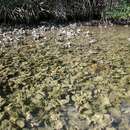Morphology
(
Anglèis
)
fornì da EOL authors
The soft body of the oyster is covered by two drab gray-colored calcareous valves joined by an organic ligament along a narrow hinge line. The valves are slightly asymmetrical. The left valve is larger and almost always deeper than the right one. The interior of the shell is smooth and white, with a single sub-central purple muscle scar. Shell shape varies from nearly oval to extremely elongate.
Reproduction
(
Anglèis
)
fornì da EOL authors
Oysters typically have spring and fall spawning peaks, although intermittent summer spawns occur. Fertilization is external. Fertilized eggs develop sequentially into trocophore , veliger and pediveliger larvae. Pediveligers have a foot which they use to explore the substrate upon which they eventually must settle. The time from fertilization to settlement is about two weeks, during which time the larvae drift with the currents. The larvae are thus the means of dispersal for this otherwise sessile organism. Larvae must find a suitable hard substrate, such as the shells of other oysters, upon which to settle. Newly attached oysters are called spat, which develop into juveniles and then into adults. Oysters are protandric hermaphrodites, meaning they reproduce first as males and later as females.
Behavior
(
Anglèis
)
fornì da EOL authors
Except for the opening and closing of their valves, the sessile adult oyster shows no externally observable behavior. Valves open for respiration, feeding and spawning. Valves close when oysters are exposed to air at low tide which helps prevent their desiccation. Vibrations and shadows produced by potential predators induce rapid shell closure. The more active larvae display a greater repertoire of behavior. Larvae are ciliated and capable of swimming. Larval behavior changes with age. As larvae age, they swim less and congregate near the bottom.
Distribution
(
Anglèis
)
fornì da EOL authors
The natural distribution of the eastern oyster is the east coast of the Americas from the Gulf of St. Lawrence in Canada to Argentina, including the Gulf of Mexico and the Caribbean. It has been introduced to the west coast of North America, Hawaii, Australia, England and Japan.
Habitat
(
Anglèis
)
fornì da EOL authors
Eastern oysters are common in estuaries of reduced salinity throughout their natural range, where they build hard bottoms variously called reefs, beds, or bars.
Conservation Status
(
Anglèis
)
fornì da EOL authors
The species is in decline over part of its range (e.g. Chesapeake Bay), but sustains viable fisheries in others (e.g., the Northern Gulf of Mexico).
Benefits
(
Anglèis
)
fornì da EOL authors
The eastern oyster is commercially exploited as a source of food and shell. Oysters are valued not only as a source of food for humans, but for the habitat they provide for other invertebrates and fishes.
Trophic Strategy
(
Anglèis
)
fornì da EOL authors
Oysters are omnivorous filter feeders that depend largely upon phytoplankton and protozoans for their nutrition.
Crassostrea brasiliana
(
olandèis; flamand
)
fornì da wikipedia NL
Crassostrea brasiliana is een tweekleppigensoort uit de familie van de Ostreidae.[1] De wetenschappelijke naam van de soort is voor het eerst geldig gepubliceerd in 1819 door Lamarck.
Bronnen, noten en/of referenties Geplaatst op:
09-03-2013
Dit artikel is een beginnetje over biologie. U wordt uitgenodigd om op bewerken te klikken om uw kennis aan dit artikel toe te voegen.

- licensa
- cc-by-sa-3.0
- drit d'autor
- Wikipedia-auteurs en -editors

